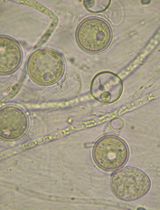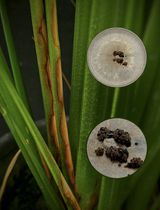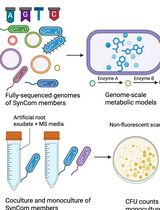- Submit a Protocol
- Receive Our Alerts
- Log in
- /
- Sign up
- My Bio Page
- Edit My Profile
- Change Password
- Log Out
- EN
- EN - English
- CN - 中文
- Protocols
- Articles and Issues
- For Authors
- About
- Become a Reviewer
- EN - English
- CN - 中文
- Home
- Protocols
- Articles and Issues
- For Authors
- About
- Become a Reviewer
Bacteria-fungal Confrontation and Fungal Growth Prevention Assay
Published: Vol 8, Iss 2, Jan 20, 2018 DOI: 10.21769/BioProtoc.2694 Views: 9891
Reviewed by: Alessandro DidonnaPushpendra SinghMichael Tscherner

Protocol Collections
Comprehensive collections of detailed, peer-reviewed protocols focusing on specific topics
Related protocols

In Vitro Screening of Microbial Extracts Against the Oomycetes Phytophthora capsici and Pythium ultimum
Mónica Trigal Martínez [...] María Ángeles Vinuesa Navarro
Sep 20, 2025 1232 Views

A Reliable In Planta Inoculation and Antifungal Screening Protocol for Rhizoctonia solani-Induced Sheath Blight in Rice
Alinaj Yasin [...] Palash Deb Nath
Nov 5, 2025 1520 Views

In Silico Prediction and In Vitro Validation of Bacterial Interactions in the Plant Rhizosphere Using a Synthetic Bacterial Community
Arijit Mukherjee [...] Sanjay Swarup
Nov 5, 2025 1617 Views
Abstract
There are some bacteria which can grow and multiply at the cost of living fungal biomass. They can potentially utilize fungi as a source of nutrients to forage over them. Such phenomenon is known as bacterial mycophagy, however, its mechanistic insights need to be explored to identify the molecules involved in mycophagy for potential utilization in controlling various fungal diseases. Recently we have demonstrated that a rice-associated bacteria Burkholderia gladioli strain NGJ1 exhibits mycophagous ability on several fungi, including Rhizoctonia solani, the necrotrophic fungal pathogen causing sheath blight disease in rice. We hereby describe our validated and efficient methods used to study B. gladioli strain NGJ1-R. solani interactions. These methodologies would be useful for designing assays to study the confrontation between bacteria and fungi which in turn enable discovery of novel antifungal molecules from such bacteria.
Keywords: Burkholderia gladioliBackground
Rhizoctonia solani is an important plant pathogenic fungi with a wide range of hosts. It causes sheath blight disease in rice; the second most devastating fungal disease of rice after Blast disease (Fisher et al., 2012; Ghosh et al., 2014; Ghosh et al., 2017). In wake of developing control methods of sheath blight disease of rice, we isolated a bacterium with a broad spectrum antifungal activity from rice seedling. Based upon the rDNA and draft genome sequencing, the bacterium had been identified as Burkholderia gladioli strain NGJ1 (Jha et al., 2015). Beside antifungal property, we observed that the NGJ1 has the ability to forage over fungi and exhibit mycophagous ability on R. solani as well as various other tested fungi. Upon interaction with R. solani mycelia, NGJ1 growth was drastically enhanced. The NGJ1 imparted cell death response in R. solani and caused disintegration of fungal mycelia. We further established that the bacteria utilize type III secretion system to deliver a prophage tail-like protein (Bg_9562) to feed on R. solani (Swain et al., 2017).
Materials and Reagents
- 1.5 ml and 2.0 ml microcentrifuge tubes (Tarson, catalog numbers: 500010 and 500020 )
- Pipette tips (10 μl) (Tarson, catalog number: 521000 )
- Pipette tips (200 μl) (Tarson, catalog number: 521010 )
- Pipette tips (1,000 μl) (Tarson, catalog number: 521020 )
- 15 ml culture tubes (Riviera, catalog number: 71200155 )
- 30 ml culture tubes (Riviera, catalog number: 71200305 )
- Microscopic glass slides (GEM, catalog number: 051 )
- Toothpicks
- Petri dishes (90 mm) (Tarson, catalog number: 460090 )
- Rhizoctonia solani AG1-IA strain (Lab collection)
- Burkholderia gladioli strain NGJ1 (Lab collection)
- Milli-Q water
- Ethanol (Merck)
- Potato dextrose agar (PDA) (HiMedia Laboratories, catalog number: GM096-500G )
- Potato dextrose broth (PDB) (HiMedia Laboratories, catalog number: GM403-500G )
- Sodium nitrate (NaNO3) (Fisher Scientific)
- Dipotassium phosphate (HiMedia Laboratories, catalog number: MB044-500G )
- Magnesium sulfate heptahydrate (MgSO4·7H2O) (HiMedia Laboratories, catalog number: GRM684 )
- Potassium chloride (KCl) (HiMedia Laboratories, catalog number: MB043 )
- Ferrous sulfate heptahydrate (FeSO4·7H2O) (HiMedia Laboratories, catalog number: GRM1377 )
- Dimethyl sulfoxide (MP Biomedicals, catalog number: 02196055 )
- Czapek dox broth (CDB) (HiMedia Laboratories, catalog number: M076-500G )
- Czapek dox agar (CDA) (HiMedia Laboratories)
- (Optional) KBA (HiMedia Laboratories, catalog number: M1544-500G )
- Potato Dextrose Agar (PDA) (see Recipes)
- Potato Dextrose Broth (PDB) (see Recipes)
- Czapek dox agar (CDA) (see Recipes)
- Czapek dox Broth (CDB) (see Recipes)
Equipment
- Forceps
- Stainless steel forceps (HiMedia Laboratories, catalog number: LA710 )
- Pipettes (Eppendorf-that can accommodate pipette tips of 10 μl, 200 μl, 1,000 μl)
- Milli-Q water purification system (Merck, model: Milli-Q® Advantage A10,catalog number: Z00Q0V0WW )
- Autoclave (INDFOS-110-PB)
- Incubator and shaker (28 °C) (mrc, catalog number: LOM-65 )
- Microcentrifuge (TOMY DIGITAL BIOLOGY, model: MX-301 )
- Laminar Air Flow (Azbil Telstar, model: Telstar Bio II Advance, catalog number: EN 12469 )
- Light microscope (Nikon, model: Eclipse E100 )
Procedure
- Bacterial-fungal confrontation assay on solid media
Note: All steps should be carried out in sterile conditions.- Pick a Rhizoctonia solani AG1-IA strain BRS1 sclerotium from approx. 2-week-old PDA plate using sterile toothpick/forceps, spot it at the center of fresh PDA plate (see Recipes) and incubate at 28 °C for a week. The R. solani sclerotium germinates to form mycelia which upon incubation produce plenty of black colored secondary sclerotia, the spore-like resting structures.
- Pick a single colony of B. gladioli strainNGJ1 from PDA plate and inoculate it in 10 ml PDB broth (see Recipes) and incubate it for 48 h at 28 °C at 200 rpm. The bacterial number is quantified using serial dilution plating and colony counting.
- Using sterile toothpick/forceps, place R. solani sclerotium at the center of PDA or CDA plate (see Recipes) and spot the B. gladioli strain NGJ1 culture (20 µl of 109 cells/ml) at four corners of the plate, equidistant from the center.
- Further, incubate the plate at 28 °C and routinely monitor for bacterial spread over fungal mycelia (Figure 1; Please note the NGJ1 spreads over fungal mycelia, induces cell death response and feed on them).

Figure 1. B. gladioli strain NGJ1 demonstrates mycophagy on R. solani. A. Growth pattern of R. solani sclerotia on PDA plates. During 3 and 5 dpi of growth, the fungal mycelia spread over petri-plate and by 7 dpi, plenty of secondary sclerotia are produced. B. Growth pattern of B. gladioli strain NGJ1 on PDA plates. Even during 7 dpi of growth, the bacteria failed to cover the entire plate (C) Confrontation of NGJ1 with R. solani on PDA plates. Initially by 3 dpi, the bacteria show limited antifungal activity but during 5 dpi, the bacteria started spreading over fungal biomass and by 7 dpi, the bacteria spread over entire fungal biomass.
- Pick a Rhizoctonia solani AG1-IA strain BRS1 sclerotium from approx. 2-week-old PDA plate using sterile toothpick/forceps, spot it at the center of fresh PDA plate (see Recipes) and incubate at 28 °C for a week. The R. solani sclerotium germinates to form mycelia which upon incubation produce plenty of black colored secondary sclerotia, the spore-like resting structures.
- Bacterial-fungal confrontation assay in liquid media
- Collect fresh sclerotia from one-week-old plate of R. solani AG1-IA strain BRS1 using sterile toothpick/forceps. Inoculate 5-10 sclerotia in 10 ml PDB/CDB broth (see Recipes) and allow them to grow for 48 h at 28 °C with constant shaking (200 rpm) to obtain mycelial mass.
- Pick a single colony of B. gladioli strain NGJ1 and inoculate it in 10 ml PDB/CDB broth at 28 °C for 48 h at 200 rpm.
- 100 µl of 109 cells/ml culture of B. gladioli strain NGJ1 was inoculated into 10 ml PDB/CDB media containing 48 h pre-grown fungal mycelial mass.
- Collect 100 µl of the bacterial solution at three different time points (24 h, 48 h and 72 h) of co-cultivation with pre-grown R. solani mycelia and upon serial dilution (105, 106, 107) plate 100 µl of bacterial solution on PDB/CDB plates. Use NGJ1 grown in absence of R. solani mycelia in PDB/CDB broth as a control.
- Incubate plates at 28 °C for 24 h and count the bacterial colonies appeared on the plate.
- Collect fresh sclerotia from one-week-old plate of R. solani AG1-IA strain BRS1 using sterile toothpick/forceps. Inoculate 5-10 sclerotia in 10 ml PDB/CDB broth (see Recipes) and allow them to grow for 48 h at 28 °C with constant shaking (200 rpm) to obtain mycelial mass.
- Sclerotial growth prevention assay
- Pick a single colony of B. gladioli strain NGJ1 and inoculate in 10 ml PDB broth and incubate at 28 °C for 48 h at 200 rpm.
- Prepare 10 ml of 109, 107, 105, and 103 cells/ml dilutions of bacterial culture using sterile PDB.
- Add 5-10 R. solani sclerotia in each of the diluted bacterial culture.
- Incubate for 4 h at 28 °C with constant shaking at 200 rpm.
- After 4 h, take out the treated sclerotia and individually place each sclerotium on fresh PDA plates.
- For control, incubate the sclerotia for 4 h in PDB broth (without NGJ1).
- Further, incubate plates at 28 °C and routinely monitor for mycelial growth.
- Pick a single colony of B. gladioli strain NGJ1 and inoculate in 10 ml PDB broth and incubate at 28 °C for 48 h at 200 rpm.
- Agar slide confrontation assay
- Clean the microscopic glass slides with ethanol and autoclave them.
- Prepare 1% agar solution (autoclaved) and gently pour 4 ml of it drop wise on the sterile glass slide to obtain thin agar layered slides. Let the agar solidify for 30 min in laminar air flow.
- Place 2 freshly collected sclerotia on both ends of the thin agar layered slides, incubate the slides in a closed sterile Petri-plate having moist tissue paper (to maintain humid condition) and allow the sclerotia to germinate at 28 °C for 24 h.
- Using a pipette, spot 20 µl of pre-grown culture (109 cells/ml) of B. gladioli strain NGJ1 at the center of the agar slides containing pre-grown R. solani mycelia.
- Incubate at 28 °C under aseptic condition and using a light microscope, observe the slides (for bacterial spread and damage of mycelia) after 24 h, 48 h and 72 h of confrontation.
- Clean the microscopic glass slides with ethanol and autoclave them.
Data analysis
All the information about data processing, statistical tests, details of replicates and independent experiments was already included in original research paper (Swain et al., [2017]. A prophage tail-like protein is deployed by Burkholderia bacteria to feed on fungi. Nature Communications. 404(8). doi:10.1038/s41467-017-00529-0).
Notes
- The R. solani sclerotial germination rate is not 100%, and this should be kept in mind while designing experiment.
- Apart from PDA and CDA; the bacterial-fungal confrontation can also be studied on King’s Medium B base (KBA, HiMedia).
Recipes
- Potato dextrose agar (PDA) for 400 ml
40 g potato infusion form
4 g dextrose
6 g agar
Add Milli-Q water up to 400 ml and autoclave the media
Pour into sterile Petri plates, let the plates completely solidify and store them at 4 °C - Potato dextrose broth (PDB) for 400 ml
40 g potato infusion form
4 g dextrose
Add Milli-Q water up to 400 ml, autoclave the media - Czapek doxagar (CDA) 400 ml
12 g sucrose
1.2 g sodium nitrate
0.4 g dipotassium phosphate
0.2 g magnesium sulfate
0.2 g potassium chloride
0.004 g ferrous sulfate
6 g agar
Add Milli-Q water up to 400 ml and autoclave the media
Pour into sterile Petri plates, let the plates completely solidify and store them at 4 °C - Czapek dox broth (CDB) 400 ml
12 g sucrose
1.2 g sodium nitrate
0.4 g dipotassium phosphate
0.2 g magnesium sulfate
0.2 g potassium chloride
0.004 g ferrous sulfate
Add Milli-Q water up to 400 ml and autoclave the media
Acknowledgments
The research funding from DBT, Government of India and core research grant from National Institute of Plant Genome Research, India to support the GJ lab are gratefully acknowledged. RK and SG acknowledge fellowship from CSIR and IT, SKY, JD acknowledges fellowship from DBT, Govt. of India. The authors declare no conflict of interest.
References
- Fisher, M. C., Henk, D. A., Briggs, C. J., Brownstein, J. S., Madoff, L. C., McCraw, S. L. and Gurr, S. J. (2012). Emerging fungal threats to animal, plant and ecosystem health. Nature 484(7393): 186-194.
- Ghosh, S., Gupta, S. K. and Jha, G. (2014). Identification and functional analysis of AG1-IA specific genes of Rhizoctonia solani. Curr Genet 60(4): 327-341.
- Ghosh, S., Kanwar, P. and Jha, G. (2017). Alterations in rice chloroplast integrity, photosynthesis and metabolome associated with pathogenesis of Rhizoctoniasolani. Sci Rep 7: 41610.
- Jha, G., Tyagi, I., Kumar, R. and Ghosh, S. (2015).Draft genome sequence of broad-spectrum antifungal bacterium Burkholderia gladiolistrain NGJ1, isolated from healthy rice seeds. Genome Announc 3: 803-815.
- Swain, D. M., Yadav, S. K., Tyagi, I., Kumar, R., Kumar, R., Ghosh, S., Das, J. and Jha, G. (2017). A prophage tail-like protein is deployed by Burkholderia bacteria to feed on fungi. Nat Commun 8(1): 404.
Article Information
Copyright
© 2018 The Authors; exclusive licensee Bio-protocol LLC.
How to cite
Kumar, R., SWAIN, D. M., YADAV, S. K., Tyagi, I., Kumar, R., Das, J., Ghosh, S. and Jha, G. (2018). Bacteria-fungal Confrontation and Fungal Growth Prevention Assay. Bio-protocol 8(2): e2694. DOI: 10.21769/BioProtoc.2694.
Category
Microbiology > Microbe-host interactions > Bacterium
Plant Science > Plant immunity > Host-microbe interactions
Do you have any questions about this protocol?
Post your question to gather feedback from the community. We will also invite the authors of this article to respond.
Share
Bluesky
X
Copy link













